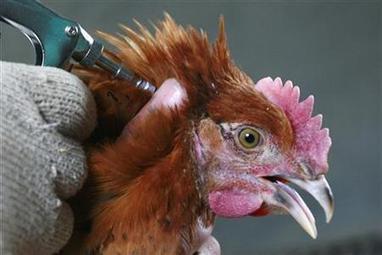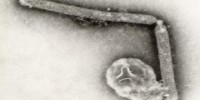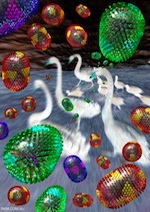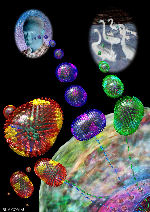Posts Tagged ‘killer flu’
1 February, 2013
So: thank you, anyone who clicked in, and regular visitors. You make it worthwhile!!
The WordPress.com stats helper monkeys prepared a 2012 annual report for this blog.

Here’s an excerpt:
4,329 films were submitted to the 2012 Cannes Film Festival. This blog had 33,000 views in 2012. If each view were a film, this blog would power 8 Film Festivals
Click here to see the complete report.
Tags:helper monkeys, HIV, Influenza, killer flu, pandemic, papillomavirus, poxvirus, retrovirus, South Africa, swine flu, vaccine, virus
Posted in biofarming, biotechnology, Ebola, Evolution, General, General Virology, HIV, Influenza viruses, Marine Viruses, plant viruses, Vaccines: General, Viruses | Leave a Comment »
11 July, 2012
See on Scoop.it – Virology News

“LONDON (Reuters) – Culls of hundreds of thousands of chickens, turkeys and ducks to stem bird flu outbreaks rarely make international headlines these days, but they are a worryingly common event as the deadly virus continues its march across the globe.
As scientists delve deeper into H5N1 avian influenza, they have discovered it is only three steps way from mutating into a potentially lethal human pandemic form, adding new urgency to a debate over how to protect humans.
In 2009, during the H1N1 swine flu pandemic, vaccines only became available months after the virus had spread around the world – and even then there was only enough for one in five of the world’s 7 billion people.
Next time, experts say, we need another approach.
Talk is centred on “pre-pandemic vaccination” – immunising people years in advance against a flu pandemic that has yet to happen, and may never come, rather than rushing to create vaccines once a new pandemic starts.”
Yes, well: regulars of this blog will recognise that I have been rattling on about this topic for some time now; nice to see serious heavyweights are starting to do the same thing.
Seriously, pre-emptive vaccination could almost certainly not hurt, would probably help a LOT – and would amp up production capacity for H5 and other potential pandemic influenza viruses [see Mexico H7N3 outbreak] as well, for pandemic vaccine production readiness.
And of course, you could do it all in plants. Just saying.
See on in.reuters.com
Tags:bird flu, flu vaccine, H5N1, killer flu
Posted in Influenza viruses, Vaccines: General | Leave a Comment »
29 June, 2012
See on Scoop.it – Virology News

“Introduction
The publication in this issue of these research papers on the airborne tranimssion [sic] of H5N1 marks the end of 8 months of controversy over whether some of the data, now freely accessible, should be withheld in the public interest.”
I think this is an important landmark in the so-called “dual use” debate: that is, the propensity of bodies in the US to attempt to regulate the release of information that MAY be usable in the making of bioweapons, or be usable in bioterror attacks.
Let us diffidently point out at this juncture that it is only really the superpowers who are definitively known in recent years to have had bioweapons programmes – apart from apartheid-era South Africa, that is! – and that damn nearly ANYTHING published on transmission or mechanisms of pathogenicity of human or animal pathogens (or even plant, for that matter) could be termed “dual use” if someone wanted to – and censored as a result.
It is also – as I tire of pointing out – possible to PROTECT against H5NX viruses using conventional vaccines right now – and the new universal flu vaccines coming on stream will almost certainly make this even more feasible.
The fact is that H5N1 flu is an ever-present threat to people living in Egypt, Indonesia, Cambodia, Viet Nam, Thailand and China – WITHOUT being weaponised. It is no more than a notional threat to the US or Europe – and keeping information that could help in understanding how or how soon the virus could mutate to pandemicity out of people’s hands, is simply stupid.
See on www.sciencemag.org
Tags:flu, H5N1, Influenza, killer flu, killer virus, superflu, supervirus, vaccine, virus
Posted in General Virology, Influenza viruses, Vaccines: General | Leave a Comment »
23 June, 2012
See on Scoop.it – Virology News

“After more than 6 months of heated discussion, the second group that succeeded in making the H5N1 avian flu transmissible between ferrets, considered a good model for human transmission, has published its results. The paper, which came out today (June 21) in Science, demonstrates that only five mutations are needed to confer this aerosol transmissibility among mammals, and that re-assortment between different types of viruses—a technique used by the other group, which published its results last month in Nature—is not necessary.
…
Said Fouchier in a press conference “We both find … loss of glycosylation at the tip of the HA molecule, and this loss of glycosylation seems to increase the receptor binding specificity of the HA”. And though not all the mutations identified in the two studies match, “the mutations that are not identical still have a similar phenotypic trait,” he added.”
So this is what all the fuss was about? This is what the NSABB did not want everyone to know? How could they POSSIBLY think that the international virology and infectious disease community should be kept in the dark about this? What this work has done has pointed the way along a path that will lead us to understand why and how influenza viruses change in order to more effectively get transmitted when they switch hosts – which is a good thing, surely.
And yet all they see is bioterrorism.
See on the-scientist.com
Tags:aerosol transmission, airborne virus, avian flu, droplet transmission, ferrets, H5N1, killer flu, superflu, supervirus, transmission, vaccine
Posted in Evolution, General Virology, Influenza viruses, Vaccines: General, Viruses | Leave a Comment »
23 June, 2012
See on Scoop.it – Virology News

It might be possible for human-to-human airborne transmissible avian H5N1 influenza viruses to evolve in nature, new research has found.
The findings, from research led by Professor Derek Smith and Dr Colin Russell at the University of Cambridge, were published June 22 in the journal Science.
Currently, avian H5N1 influenza, also known as bird flu, can be transmitted from birds to humans, but not (or only very rarely) from human to human. However, two recent papers by Herfst, Fouchier and colleagues in Science and Imai, Kawaoka and colleagues in Nature reveal that potentially with as few as five mutations (amino acid substitutions), or four mutations plus reassortment, avian H5N1 can become airborne transmissible between mammals, and thus potentially among humans. However, until now, it was not known whether these mutations might evolve in nature.
The Cambridge researchers first analysed all of the surveillance data available on avian H5N1 influenza viruses from the last 15 years, focusing on birds and humans. They discovered that two of the five mutations seen in the experimental viruses (from the Fouchier and Kawaoka labs) had occurred in numerous existing avian flu strains. Additionally, they found that a number of the viruses had both of the mutations.
Colin Russell, Royal Society University Research Fellow at the University of Cambridge, said: “Viruses that have two of these mutations are already common in birds, meaning that there are viruses that might have to acquire only three additional mutations in a human to become airborne transmissible. The next key question is ‘is three a lot, or a little?’ “
So: was it a good idea to publish those two papers on mutating H5N1 viruses, or not? Given that as I and many other more famous people pointed out, if you don’t know what makes the viruses mammal-to-mammal transmissible, you don’t know what to look for – and now we do, and look what they found. This story will run, and run, and run – so we really, really should include an H5 consensus HA in seasonal flu vaccines!!
See on www.sciencedaily.com
Tags:aerosol transmission, droplet transmission, ferrets, H5N1, killer flu, supervirus, vaccine
Posted in Evolution, General Virology, Influenza viruses, Vaccines: General, Viruses | Leave a Comment »
19 April, 2012
The Scientist has a nice collection of articles on this topic, which I have commented on all over the place, so I though I might consolidate some of it in one place.

In response to the article entitled “Deliberating Over Danger“, I wrote the following:
The point I and others have made before is that H5N1 and other influenza viruses are not waiting for us to let engineered versions loose, before they cause pandemics: all of the mutations noted by the Fouchier and Kawaoka groups are almost certainly present in the several environments where H5N1 viruses are now endemic – and all it takes for all of them to be present together is a little more mixing.
Don’t discount other flu subtypes, either: while everyone is obsessing about H5N1, H3N2 is busy popping out of pigs in the USA; H9N2 in birds in Bangladesh; H5N2 in ostriches in South Africa – and all it would take is one or a couple of fortuitous reassortments, and a whole new flu virus could be unleashed.
While the “deadly” H5N1s are being worked on in lockdown facilities.
If we don’t know what the virus does, we won’t know what it can do. If we don’t know what to look for, we may be taken unawares, when the next 1918-type pandemic strikes.
I want to have universal flu vaccines by then – so we won’t HAVE to worry about a new flu
.
There are also three newer articles covering the controversy: these are
There is the slightly older article – “Bird Flu Papers to Publish” – describing the reversal of the NSABB’s decision to ask for redaction of the two papers describing mammal-to-mammal aerosol-transmissible H5N1.
An interesting article also describes Yoshihiro Kawaoka’s results:
“First, he introduced two mutations—N224K and Q226L—into the haemagglutinin (HA) protein of H5N1 that made the virus capable of sticking to receptors on human tracheal cells. Then he created a chimeric virus by combining the mutated HA protein with genes from the H1N1 virus, which sparked a pandemic in 2009. Kawaoka identified another HA mutation, called N158D, that allowed the virus to spread between ferrets that were not in direct physical contact. A fourth mutation, T318I, also showed up in the H5N1 strain, but its role in making the virus more transmissible among mammals is less clear.”
So there you are: an actual recipe for aerosol-transmissible H5N1. It was always going to come out somehow, and now these two papers will probably the most cited flu papers ever. Nothing like a little hype! Meanwhile, H5 and its brothers and sisters are out there mutating away, with no help needed from anyone. Roll on universal flu vaccines!!
Tags:bird flu, Fouchier, H5N1, Influenza, Kawaoka, killer flu, pandemic, swine flu, vaccine
Posted in Evolution, General Virology, Influenza viruses, Vaccines: General, Viruses | Leave a Comment »
8 February, 2012
…Elsevier’s Virology was calmly publishing another paper on a “mutant” H5N1….

The abstract:
Acquisition of α2-6 sialoside receptor specificity by α2-3 specific highly-pathogenic avian influenza viruses (H5N1) is thought to be a prerequisite for efficient transmission in humans. By in vitro selection for binding α2-6 sialosides, we identified four variant viruses with amino acid substitutions in the hemagglutinin (S227N, D187G, E190G, and Q196R) that revealed modestly increased α2-6 and minimally decreased α2-3 binding by glycan array analysis. However, a mutant virus combining Q196R with mutations from previous pandemic viruses (Q226L and G228S) revealed predominantly α2-6 binding. Unlike the wild type H5N1, this mutant virus was transmitted by direct contact in the ferret model although not by airborne respiratory droplets. However, a reassortant virus with the mutant hemagglutinin, a human N2 neuraminidase and internal genes from an H5N1 virus was partially transmitted via respiratory droplets. The complex changes required for airborne transmissibility in ferrets suggest that extensive evolution is needed for H5N1 transmissibility in humans. [my emphasis – Ed]
I have covered the use of glycan arrays to characterise influenza viruses’ binding specificity previously; I thought then, and do now, that it is a very cool technology – and one that has shown in this case that H5N1 variants can be selected from an originally “wild” population, that preferentially bind the human-type receptor.
And they did it like this:
To examine the functional evolution of H5 HA receptor specificity in the laboratory, we implemented an in vitro receptor-binding virus enrichment approach that recapitulates in vivo selection. Synthetic 6′-sialyl (N-acetyl-lactosamine) (6′ SLN) was used as the affinity ligand mimicking the human receptor to capture spontaneous viral receptor variants on the surface of magnetic beads. Starting with a pool of 108 EID50 of A/Vietnam/1203/2004 (VN04 virus), we performed four consecutive rounds of in vitro binding and elution followed by isolation of 150 individual virus clones by plaque purification and characterization by sequence analysis.
No “genetic engineering” here – or furore over “killer viruses escaping the lab!” Possibly because (a) “mutant virus was transmitted by direct contact in the ferret model although not by airborne respiratory droplets”, and (b) “a reassortant virus with the mutant hemagglutinin, a human N2 neuraminidase and internal genes from an H5N1 virus was partially transmitted via respiratory droplets” [my emphasis].
Meaning they didn’t actually make anything that could immediately elicit such scare-mongering as the more notorious studies I and many others have reported on previously.
However, the grim NSABB folk were quick to decry the publication, saying “”I think it is fair to say that we would have liked to have seen it before it was published,” [Paul Keim, chairman of the National Science Advisory Board for Biosecurity], and the “…altered bird flu virus could mutate in dangerous ways if unleashed in nature”.
I am more worried, to be perfectly honest, over the dangerous ways the the wild type virus could mutate IN nature, given that mutants can be selected so apparently easily!
Tags:bird flu, H5N1, Influenza, killer flu, prevention, swine flu, vaccine
Posted in Evolution, General Virology, Influenza viruses, Vaccines: General | 1 Comment »
17 January, 2012
In an issue of Virus Research devoted to commemorating the career of Brian Mahy, who retired recently from the CDC and now as Editor-in-Chief of Virus Research, there is a paper by Taubenberger and Kash on the 1918 H1N1 flu – wherein they say the following:
“In a recent set of experiments, it was shown that mice vaccinated with the monovalent 2009 pandemic H1N1 vaccine were completely protected in a lethal challenge model with the 1918 influenza virus…”
Because the modern pandemic “swine flu” H1N1 HA protein descends directly from the 1918 virus, but in pigs rather than in humans. Remember all the hype around THAT work – resurrecting the legendary Spanish Flu, and how it would kill us all? And here we already have a vaccine, that will completely protect us.
We have vaccine candidates against H5 as well. Time for a universal flu vaccination campaign and pre-emptive strike, people!
Tags:H1N1, H5N1, Influenza, killer flu, swine flu, vaccine
Posted in Evolution, General Virology, Influenza viruses, Vaccines: General | Leave a Comment »
16 January, 2012
The Independent today has a story entitled”Killer flu doctors: US censorship is a danger to science” – thanks, AJ Cann! – which details how the folk in the Netherlands who did the work do not think the USA should not be “…be allowed to dominate the debate over who controls sensitive scientific information that could be misused in biowarfare terrorism”.

Influenza A viruses mixing in susceptible hosts
Well, yes, join the club, guys! The article is quite reasonable – apart from a couple of points, noted below – but it ends on a suitably alarmist note “…the chances of a laboratory strain of H5N1 escaping into the wild remain high if it is stored in conventional flu-virus labs”, and “Regulators should not be sitting idly by, while the threat of a man-made pandemic looms”. Really? The undoubtedly very small amount of mutated flu that exists, relative to any engineered bioweapon in US or Russian labs, represents a clear and present threat to world health?
What dismayed me most, however, was how horrifyingly uninformed most of the commenters are – about H5N1 in particular, and science and science funding in general….! As I could not comment there – Disqus broke, apparently – I will do so here.
As for labelling the article “Killer Flu Doctors” – really! A little sensationalism, anyone?? Concerning the comment “…the details could be misused by rogue states or by biowarfare terrorists with access to rudimentary scientific knowledge and fairly standard laboratory equipment”: as a practicing molecular virologist, I can tell you that you would need a lot more than “rudimentary scientific knowledge” – you’d need skill in molecular biology, and especially in reverse genetics of (-)strand RNA viruses, as well as more than “fairly standard equipment” to even BEGIN to hope to make anything like a “killer” H5N1 from published details.
Additionally, a H5 N1 flu virus that is aerosol transmitted in ferrets – and how efficient was that, I ask? – may NOT be similarly transmissible or as easily (if it was easy) between humans. I will point out that people thought the SARS CoV outbreak was the “Big One” flu pandemic – but although it was aerosol transmissible, it wasn’t nearly as efficiently transmitted as the common flu, so did not spread as fast.
Thus, most of what the doomsayers are predicting could be simply hype – meanwhile, in countries far away from the US which seeks to regulate such work, the virus is already endemic, and mutating freely – and it would be VERY useful indeed to know what to look for!
Tags:H1N1, H5N1, Influenza, killer flu, pandemic, prevention
Posted in Evolution, General Virology, Influenza viruses | 1 Comment »
13 January, 2012

Influenza A viruses carried by birds
I have been doing quite a lot of digging into virus history recently, and it was interesting to pick up – while checking on who had published what from our University on viruses – a paper from 1966 describing “The isolation and classification of Tern virus: Influenza Virus A/Tern/South Africa/1961″ by WB Becker of the Virus Research Unit here at UCT. It is interesting because it was isolated from sick migratory Common Terns along the south coast of South Africa, which were infected as part of an “explosive epizootic” which resulted in many deaths. It became more interesting when it was shown in 1967 to cause few or no symptoms in Swift Terns but was shed in large amounts, to be highly pathogenic in chickens, and was subsequently typed as H5N3.
The discussion of the original paper was not only highly prescient, but may be completely valid today: a significant quote follows.
The isolation of Tern virus raises interesting epidemiological possibilities. The outbreak in chickens in Scotland caused by Chicken/Scot. virus preceded the Tern epizootic by about 17 months and occurred during stormy weather which drove sea-birds a little inland to take shelter. Large numbers ofHerring Gulls (Larus argentatus) were at that time working thef arm at which the out break in chickens occurred in November 1959 (J. E. Wilson, personal communication). The chickens might have contracted the infection from sea-birds, a viewpoint possibly supported by the preceding mass mortality in Kittiwakes (Rissa tridactyla) and Fulmars (Fulmaris glacialis) from February to August 1959 (Joensen, 1959) off the coast of Britain and Scandinavia. Unfortunately the aetiology of the last-mentioned outbreak was not investigated, but it is tempting to think it was caused by the Tern virus which was isolated at Cape Town some 18 months later in 1961, from migrant European Common Terns.
One might postulate: that certain sea-birds suffer latent or sporadic infection with avian influenza; that epizootics may be precipitated in them by conditions of stress, e.g. poor feeding under unfavourable weather conditions such as pre- ceded the Tern epizootic; and that spread to other sea-birds or domestic poultry may occur. [my emphases – Ed]
The 1967 tern infection paper continues this theme:
The outbreak in chickens in Scotland in 1959 (Dr J. E. Wilson, personal communication) and the Tern epizootic in 1961 were caused by influenza A viruses with closely related strain specific antigens which were unrelated to those of any previously known influenza A viruses. Recently strains of influenza A related to the Tern and Scottish viruses were isolated from turkeys in Canada (Dr G.Lang, personal communication). This lends further support to the hypothesis that migrating sea-birds such as the Common Tern may transmit avian influenza A viruses to domestic poultry.
This was followed up more recently (2002) by a paper describing transmission of the tern virus to laughing gulls:
This investigation detailed the clinical disease, gross and histologic lesions, and distribution of viral antigen in juvenile laughing gulls (Larus atricilla) intranasally inoculated with either the A/tern/South Africa/61 (H5N3) (tern/SA) influenza virus or the A/chicken/Hong Kong/220/97 (H5N1) (chicken/HK) influenza virus, which are both highly pathogenic for chickens. Neither morbidity nor mortality was observed in gulls inoculated with either virus within the 14-day investigative period. Gross lesions resultant from infection with either virus were only mild…. Antibodies to influenza viruses …at 14 DPI were detected only in the two tern/SA-inoculated gulls and not in the two chicken/HK-inoculated gulls.
Their conclusions, too, were rather disturbing:
The positive isolation of the tern/SA and chicken/HK viruses from the OP and cloacal swabs suggests that, with adequate exposure, gulls could serve as hosts for these and possibly other HPAI viruses. Isolation of the A/gull/Germany/79 (H7N7) virus during a HPAI outbreak in Eastern Europe provides further evidence to support the potential for pelagic birds to serve as biological vectors for (HP)AI viruses (D. J. Alexander, pers. comm., originally referenced in 29). This is a significant finding in terms of the epidemiology of AI viruses, especially considering the fact that the chicken/HK virus was a zoonosis (26,27). Moreover, pelagic birds have been implicated as the source for other AI viruses that transmitted to and may have caused disease in mammals (8,13).
Everybody is obsessed with H5N1: maybe we should be a little more concerned with what may be raining down from above, as seabirds carry recombinant / reassortant viruses from areas of high H5N1 endemicity around the world.
Tags:bird flu, H5N1, H5N3, Influenza, killer flu, pandemic, tern virus
Posted in Evolution, General Virology, Influenza viruses, Vaccines: General | Leave a Comment »









